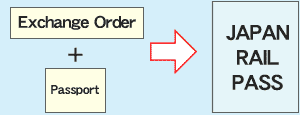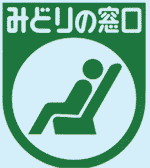| JAPAN RAIL PASS types and prices
There are two types of JAPAN RAIL PASS: Green (for superior-class Green cars), and Ordinary. Each of these types is available as a 7-day, 14-day, or 21-day PASS.See "JAPAN RAIL PASS validity", for services that can be used with a JAPAN RAIL PASS.
|
|||||||||||||||||||||||||
JAPAN RAIL PASS validity
1. Transportation services
| ❏ | The JAPAN RAIL PASS is valid for the railways, buses, and ferry boats shown in Table 1. |
| Railways: | All JR Group Railways-Shinkansen"bullet trains" (except any reserved or non-reserved seat on “NOZOMI”and”MIZUHO”trains)limited express trains, express trains, and rapid or local trains. (With some exceptions) *JAPAN RAIL PASS holders can also use the Tokyo monorail. *Aoimori Railway (Metoki-Aomori. However, the use of local or rapid trains between Aomori-Hachinohe, Aomori-Noheji and Hachinohe-Noheji is permitted. Passengers disembarking on Aoimori Railway lines in these sections must pay separate fares. However, passengers disembarking at Aomori Station, Noheji Station, or Hachinohe Station do not need to pay separate fares. |
| Buses: | Local lines of JR bus companies*1 (excluding some local lines) (Pass validity for particular routes is subject to change.) *1 JR Hokkaido Bus, JR Bus Tohoku, JR Bus Kanto, JR Tokai Bus, West Japan JR Bus, Chugoku JR Bus, JR Kyushu Bus *The PASS is not valid for travel on express bus routes operated by JR bus companies. |
| Ferry: | Only the JR Miyajima ferry is covered. The JR Hakata-Pusan (Korea) ferry is not covered. |
| Important notes: The JAPAN RAIL PASS is not valid for any seats, reserved or non-reserved, on “NOZOMI” and “MIZUHO” trains on the Tokaido, Sanyo and Kyushu Shinkansen lines. (The pass holders must take “HIKARI,” “SAKURA,” “KODAMA,” or “TSUBAME” trains.) If you use a “NOZOMI” or “MIZUHO” train, you must pay the basic fare and the limited express charge, and for a Green Car the Green Car surcharge. In addition, if you use the GranClass car of the Tohoku Shinkansen, you must pay the limited express charge and the GranClass car surcharge. Note also that passengers using JR trains on non-JR lines must pay additional fares and charges for sections traveled on such lines. |
|
| Some JR trains use the lines of private railways for direct services. | |
Table 1 |
|
|
2. Train accommodations
| ❏ | Most JR trains have Ordinary Cars (coach class) while many long-distance trains also offer Green Cars (superior class). With a Green-type JAPAN RAIL PASS you can use either class, while with an Ordinary-type JAPAN RAIL PASS you can use only Ordinary Cars without paying an additional charge. Refer to the table2 below for details. |
| ❏ | The cars with |
| ❏ | Use of the cars with |
| ❏ | There are no Green Cars on most HIKARI and KODAMA trains on the Sanyo Shinkansen line (Shin-Osaka ·Hakata), or on TSUBAME trains on the Kyushu Shinkansen line(Shin-Yatsushiro – Kagoshima- chūō ) |
Trains |
Accomodations |
Green |
Ordinary |
||||||||||||||
“NOZOMI” and “MIZUHO” trains on the Tokaido, Sanyo and Kyushu Shinkansen*1 |
Green Car | ||||||||||||||||
| Ordinary Car | |||||||||||||||||
| “HIKARI,” “SAKURA,” “KODAMA” and “TSUBAME” trains on the Tokaido, Sanyo and Kyushu Shinkansen and any trains on the Tohoku, Yamagata, Akita, Joetsu and Nagano Shinkansen. | GranClass *4 | ||||||||||||||||
| Green Car | |
|
|||||||||||||||
| Ordinary Car | |||||||||||||||||
| Ordinary private Compartment | |||||||||||||||||
Limited express and ordinary express |
Green Car | ||||||||||||||||
| Ordinary Car | |||||||||||||||||
| Green private Compartment | |||||||||||||||||
| Ordinary private Compartment | |||||||||||||||||
| Sleeping Car | |||||||||||||||||
Local and rapid trains |
Green Car | ||||||||||||||||
| Ordinary Car | |||||||||||||||||
Table 2 Remarks:
|
|||||||||||||||||
3. Validity period
| ❏ | The validity period of a JAPAN RAIL PASS is the consecutive 7, 14, or 21 days beginning on the date the PASS is first used. |
| ❏ | Within three months from the date the Exchange Order was issued, you must turn in your Exchange Order to obtain your JAPAN RAIL PASS (for example, an Exchange Order issued on April 15 would have to be turned in by July 14). At that time, you have to specify the date that you want to start using the PASS. It can be any date within one month from the date the PASS is received. |
| ❏ | Once the PASS has a starting date written on it, the date cannot be changed. |
How to turn in an exchange order to receive a JAPAN RAIL PASS

| ❏ | You cannot use an Exchange Order when you travel on JR lines. Turn in your Exchange Order and obtain your JAPAN RAIL PASS at one of the JAPAN RAIL PASS exchange offices. shown on the pages to the right. (Please note the Service hours and closing days.) *It may take time to turn in your Exchange Order and receive a JAPAN RAIL PASS if the service counter is busy. Please ensure you leave enough time when you visit the exchange office. |
|
| ❏ | Your Exchange Order must be turned in for a JAPAN RAIL PASS within three months of the date the Order was issued.(for example, an Exchange Order issued on April 15 would have to be turned in by July 14) | |
| ❏ | At the exchange office, you will be asked to fill in a short application form and to show your passport with the Temporary Visitor stamp/sticker you received on entry into Japan. You must show your passport and this stamp/sticker to process the Rail Pass Exchange Order. |
|
| * You are a Japanese national living in a country other than Japan (having entered the country on a Japanese passport), a. who has the right of permanent residence in that country b. who is married to a non-Japanese residing in a country other than Japan. Note: Present the following documentation along with your Japanese passport when you purchase the Exchange Order and when you exchange it for a JAPAN RAIL PASS: Persons meeting condition (a) must provide written proof of the following: ・Right of permanent residence ・That they are living in a country other than Japan Persons meeting condition (b) must provide written proof of the following: ・That they are living in a country other than Japan ・That they are married to a foreign national ・That their spouse (a foreign national) is living outside Japan |
||
|
||
| ❏ | The type of PASS described on the Exchange Order cannot be changed. | |
| ❏ | If the Exchange Order is lost or stolen, or you are unable to provide it for another reason, no exchange for a JAPAN RAIL PASS can be made. | |
| ❏ | You will not be able to exchange your Exchange Order for a PASS if you fail to satisfy the eligibility requirements. |
How to make seat reservations
Caution:
|
